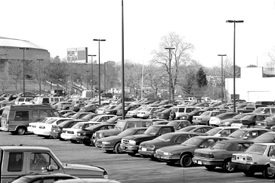The University Record, November 15, 1999 By Rebecca A. Doyle

Like vultures circling above their prey, an increasing number of cars driven by U-M faculty and staff can be found circling parking lots and structures on Central Campus.
And much like airline companies, the University’s Parking Services has a long-standing policy of issuing parking permits in excess of the number of spaces available.
But that policy of issuing permits to all eligible staff who wish to purchase them is not the only factor in the parking crunch—sometimes a literal crunch, as desperate drivers fight to win a parking spot—that has plagued the campus since late September. Patrick Cunningham, director of Parking and Transportation Services, says that an increase in eligible faculty and staff at the University—specifically on Central Campus—also is a contributing factor. The number of faculty and staff eligible to purchase permits has increased by more than 5,000 in the past 10 years, and Cunningham says that Central Campus parking spaces have not increased significantly in the past 25 years.
“My goal,” Cunningham says, “is to create at least 1,000 more spaces for Central Campus. The problem is that there is no more room for surface parking without taking away existing spaces, and we don’t want to do that.”
Cunningham, who either rides a bike to work or parks in one of the outlying commuter lots and rides the bus to his Thompson Street office, also says that parking availability is at its worst in the winter, and he expects that difficulties will increase this year.
That worries a lot of people, including members of the Senate Advisory Committee on University Affairs (SACUA). SACUA voted Nov. 8 to send a letter to both Henry D. Baier, associate vice president for facilities and operations, and Executive Vice President and Chief Financial Officer Robert Kasdin expressing SACUA’s contention that the parking crunch is a serious problem about to become worse with the onset of winter’s cold, slush and snow.
SACUA members said they are unhappy that permits, particularly Blue permits, had been sold in excess of available spaces. Blue parking lots and structures are usually within a very short distance of most U-M buildings and are the most popular permit sold.
Cunningham says in past years the ratio of 1.3 permits issued for every parking space available has not been a problem because not every permit holder wants to park a car every day.
Now, however, it has become a problem on Central Campus, where there are only 2,982 Blue spaces (there are 4,589 on Medical Campus). If only one-third of the 12,378 Blue permit holders want to park on Central Campus, there are nearly 1,000 too few spaces.
Cunningham’s long-term solutions—sharing the Forest Street parking structure with the city of Ann Arbor and building a new parking structure near Central Campus—would help alleviate the problems within two or three years. But SACUA and others are more concerned with the immediate future—the fast-approaching, high-demand winter months.
Short-term solutions include taking advantage of the U-M’s transportation system, Cunningham says, better control of illegal parking in designated structures and surface lots, and encouraging innovative work programs such as flexible work schedules and the virtual office.
“There is no simple solution to the parking conundrum,” he says. “There are many parts to the solution, including new structures, more remote parking, encouraging people to walk to meetings on campus and instituting options that fit individuals’ lifestyles.”
Help ease the parking squeeze
Despite 400 new spaces in commuter lots and 71 new parking slots in Blue parking on Central Campus, parking near offices and classrooms has become increasingly difficult. To help alleviate the crunch—and to make parking easier for yourself—here are some alternatives to explore:
Ride a bus to work
Bus pass holders may purchase daily scratch-off parking permits in packs of 10 for those days they must drive their vehicle to campus.
Ann Arbor Pioneer High School (Stadium Blvd. at Main Street): Route 7 & 2, or 14.
Maple Village Shopping Center (Maple Road, between Dexter and Jackson): Route 12U.
Lot NC37 (Green Road, near Baxter Road): Route 2.
Lot SC34 (South State Street, across from car dealership): Route 36.
Presentation of a valid U-M identification card is required. Bus schedules are available from the AATA and the Parking Services office.
Afraid you’ll miss the last bus and not be able to get to your car? Glazier Ride is a free evening taxi service to the Glazier Way Commuter lot.
Request rides at the North Campus Commons Administrative Office (2nd floor) or at the Engineering Library circulation desk. The Department of Public Safety Escort Service is available to all members of the University community when other resources are not available or not appropriate for a particular situation. Upon receipt of a call, a uniformed Public Safety employee in a marked car will respond and drive you to your campus destination. This service is available 24 hours a day, seven days a week.
Want to make sure you can get back to your car quickly in an emergency? Guaranteed Ride Home (GRH) guarantees a ride home or to the car anywhere in Washtenaw County for those holding AATA bus passes. Emergency Ride Home (ERH) provides free rides to any location, even outside Washtenaw County, for faculty and staff who use Park & Ride lots; Green, Orange or Yellow permit lots; those who ride in a van or car pool; and those who do not park at all.
Pool it
Be flexible

